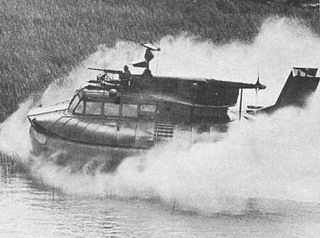
A hovercraft, also known as an air-cushion vehicle or ACV, is an amphibious craft capable of travelling over land, water, mud, ice, and various other surfaces.

The SR.N4 hovercraft was a combined passenger and vehicle-carrying class of hovercraft. The type has the distinction of being the largest civil hovercraft to have ever been put into service.
Black Knight was a British research ballistic missile, originally developed to test and verify the design of a re-entry vehicle for the Blue Streak missile. It is the United Kingdom's first indigenous expendable launch project.
Hoverspeed was a ferry company that operated on the English Channel from 1981 until 2005. It was formed in 1981 by the merger of Seaspeed and Hoverlloyd. Its last owners were Sea Containers; the company ran a small fleet of two high-speed SeaCat catamaran ferries in its final year.
Cushioncraft Ltd was a British engineering company, formed in 1960 as a division of Britten-Norman Ltd to develop/build hovercraft. Originally based at Bembridge Airport on the Isle of Wight, Cushioncraft later moved to the Duver Works at St. Helens, these works gave ready access to the sheltered water of Bembridge Harbour.

British Hovercraft Corporation (BHC) was a British hovercraft manufacturer that designed and produced multiple types of vehicles for both commercial and civil purposes.
Hovertravel is a ferry company operating from Southsea, Portsmouth to Ryde, Isle of Wight, UK. It is the largest passenger hovercraft company currently operating in the world since the demise of Hoverspeed.

The Egyptian Navy, also known as the Egyptian Naval Force, is the maritime branch of the Egyptian Armed Forces. It is the largest navy in the Middle East as well as Africa, and is the twelfth largest navy in the world. The navy protects more than 2,000 kilometers of coastline of the Mediterranean Sea and the Red Sea, defense of approaches to the Suez Canal, and it also supports for army operations. The majority of the modern Egyptian Navy was created with the help of the Soviet Union in the 1960s. The navy received ships in the 1980s from China and Western sources. In 1989, the Egyptian Navy had 18,000 personnel as well as 2,000 personnel in the Coast Guard. The navy received ships from the US in 1990. US shipbuilder Swiftships has built around 30 boats for the Egyptian Navy including mine hunters, survey vessels, and both steel and aluminium patrol boats.

Griffon Hoverwork Ltd (GHL) is a British hovercraft designer and manufacturer.

The Saunders-Roe SR.N1 was the first practical hovercraft. The concept has its origins in the work of British engineer and inventor Christopher Cockerell, who succeeded in convincing figures within the services and industry, including those within British manufacturer Saunders-Roe. Research was at one point supported by the Ministry of Defence; this was later provided by the National Research Development Corporation (NRDC), who had seen the potential posed by such a craft.
Seaspeed was a British hovercraft operator which ran services in the Solent and English Channel between 1965 and 1981, when it merged with a rival to form Hoverspeed.

Hoverlloyd operated a cross-Channel hovercraft service between Ramsgate, England and Calais, France.

The Czilim-class ACV is a small patrol hovercraft operated by the Border Service of the FSB of Russia.

The Saunders-Roe SR.N6 hovercraft was essentially a larger version of the earlier SR.N5 series. It incorporated several features that resulted in the type becoming one of the most produced and commercially successful hovercraft designs in the world.

The British Hovercraft Corporation AP1-88 is a medium-size hovercraft. In a civil configuration, the hovercraft can seat a maximum of 101 passengers, while as a troop carrier, it can transport up to 90 troops. When operated as a military logistics vehicle, the AP1-88 can carry a pair of Land Rovers, a Bv202 tracked vehicle and trailer unit or up to roughly 10 tons (10,000 kg) of cargo.

The Griffon 2000 series is a light-weight hovercraft built in the United Kingdom by Griffon Hoverwork and used principally by military and rescue organisations.

The Saunders-Roe SR.N5 was a medium-sized hovercraft which first flew in 1964. It has the distinction of being the first production-built hovercraft in the world.

Martlet or the Lightweight Multirole Missile(LMM) is a lightweight air-to-surface, air-to-air, surface-to-air, and surface-to-surface missile developed by Thales Air Defence for the United Kingdom. It is named after a mythical bird from English heraldry that never roosts, the Martlet.

The Fleet-class unmanned surface vessel, also called the Common Unmanned Surface Vessel (CUSV) and later the Mine Countermeasures Unmanned Surface Vehicle, is an unmanned surface vessel designed for the United States Navy to be deployed from Freedom and Independence-class littoral combat ships and intended to conduct mine and anti-submarine warfare missions. As of 2012 four units of the class have been built; the first was delivered to the U.S. Navy in 2008.

The Tondar is a hovercraft designed and manufactured by Iran. The Islamic Republic of Iran Navy is equipped with two variants of this craft, one for combat and one for transport missions, of which the Tondar is the combat type. General Ahmad Vahidi unveiled it in a ceremony in November 2012. According to the Fars news agency, the Tondar can be used with different types of weapons, including rockets, guns and can also launch UAVs.















